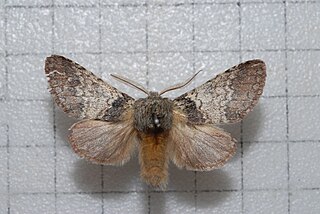
Oenosandridae is a family of Australian noctuoid moths. Genera include:

Notodontidae is a family of moths with approximately 3,800 known species. The family was described by James Francis Stephens in 1829. Moths of this family are found in all parts of the world, but they are most concentrated in tropical areas, especially in the New World.

The coxcomb prominent is a moth of the family Notodontidae. It is a common species throughout the Palearctic realm from Ireland to Japan. It was first described by Carl Linnaeus in his 1758 10th edition of Systema Naturae.

The buff-tip is a moth of the family Notodontidae. It is found throughout Europe and in Asia to eastern Siberia. The species was first described by Carl Linnaeus in his 1758 10th edition of Systema Naturae.

Noctuoidea is the superfamily of noctuid or "owlet" moths, and has more than 70,000 described species, the largest number of any Lepidopteran superfamily. Its classification has not yet reached a satisfactory or stable state. Since the end of the 20th century, increasing availability of molecular phylogenetic data for this hugely successful radiation has led to several competing proposals for a taxonomic arrangement that correctly represents the relationships between the major lineages.

Americerura scitiscripta, the black-etched prominent, is a moth of the family Notodontidae. It is found from Quebec west to eastern Alberta, south to Florida and Texas. The species was formerly placed the genus Tecmessa, and the genus Cerura, which is now restricted to the Old World.

Dioptinae is a subfamily of the moth family Notodontidae.
Oricia is a genus of moths of the family Notodontidae. It was described in 1854 by English entomologist Francis Walker and contains four species distributed in Central and South America.
Momonipta is a genus of moths of the family Notodontidae. It consists of the following species:

Disphragis is a genus of moths of the family Notodontidae erected by Jacob Hübner in 1820. The genus is confined to the New World and it contains about 137 species.
Nebulosa delicata is a moth of the family Notodontidae first described by James S. Miller in 2008. It is found in western Ecuador as far north as Chical on the Colombian border.
Dolophrosyne sinuosa is a moth of the family Notodontidae first described by James S. Miller in 2008. It is found in the Cosnipata Valley east of Cuzco in Peru.

Pseudofentonia is a genus of moths of the family Notodontidae erected by Embrik Strand in 1912.

Somera is a genus of moths of the family Notodontidae. The genus was erected by Francis Walker in 1855.
Somera viriviri is a moth of the family Notodontidae that is endemic to Sulawesi.
Nystaleinae is a subfamily of the moth family Notodontidae. The subfamily was described by William Trowbridge Merrifield Forbes in 1948.

Heterocampinae is a subfamily of prominent moths in the family Notodontidae. There are at least 60 described species of Heterocampinae in North America.

Dudusa is a genus of moths in the family Notodontidae. It was first described by Francis Walker in 1865. Moths in genus Dudusa are large, with yellow to ochre forewings and brown hindwings, and show little sexual dimorphism. Species occur in Asia, with the most diversity in Indochina.











